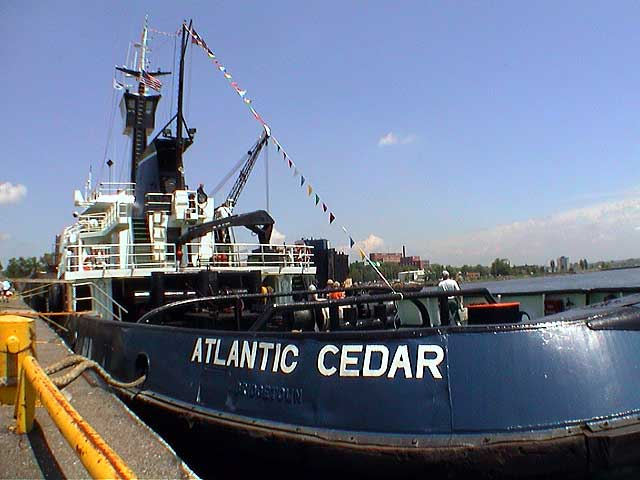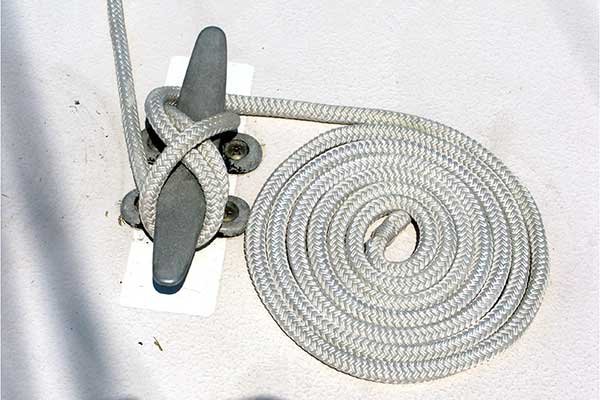OK, we all do it. But that doesn't make it right.
I know the majority of pleasure boaters tie their boats with the eye loop of their dock lines on their boat's cleats, with the rest of the line cleated off on the dock, the excess usually coiled up Flemish-style or in a neat pile next to the cleat. For small boats that may be fine, but when we start cruising on bigger boats, power or sail, things change.
And here is where one needs to look around to see how it is done by the pros, especially on commercial docks. Except for very small craft, you will NEVER see fishing boats, tugs, rescue, or military vessels tied up this way, and I don't just mean large ships. Unless the dock lines are looped around bollards and back to the vessel, the eye splice of the dock line is ashore, around a bollard or cleat.
Well, I think there is a case to be made for doing it this way, unless you are short handed and there is no one on the dock. Besides any practical reasons to do it this way, it is also about perspective.
You are tying your boat to the dock, not the other way around. And it is a bit like thinking that you control the world from the boat, not control your boat from the world. Think about it. In an odd way, it reminds me of taking responsibility for one's situation, rather than expecting others to come to the rescue when one needs help. This is a primary characteristic of the successful passagemaker. He or she does not make a successful cruise due to luck, but because they leave little to chance, at least what is in their control. And they would never rely on the unknown abilities of some kid on the fuel or transient dock. The chuck of fiberglass that came out of my bow was a lesson brought home on Long Island Sound one summer day. Lesson learned.
Let's continue with this perspective thing. Imagine your typical couple doing the popular Great Loop. As is true in many cases that I know of, it is his dream and he longs to finally make it happen. His wife goes along with it because that is the easiest path, the way to get this done, hopefully have some fun, and then return to the grandchildren. I've seen it a zillion times.
Now imagine how the mental perspective changes from spectator to participant. Instead of her throwing (or handing over) an armful of rope to a guy on the dock, as she has done so many times during their initial miles on the Loop, she instead gives him the eye loop of the dock line, instructing the fellow to just place it around that particular dock cleat. It is now on her...she owns it. She adjusts the line from the boat as she helps her husband get the boat situated just right. She feels empowered,..and necessary. GUYS GET THIS. She is no longer along for the ride, she is invested in this adventure. She will learn the ropes, literally. And perhaps over time become interested in driving the boat so he can deal with the wet lines and dirty fenders!
The benefits of this perspective are priceless. They become a cruising team. And I meet them again at some later boat show and she explains they are there to put a deposit on a larger, new boat so she can gather the family together for the holidays in the islands. The guy is all smiles as he takes me aside and tells me he never would have dreamed he would be buying a new 50-foot boat to satisfy his wife. True story.
I recall one Trawler Fest where a couple on a rather nice trawler approached the dock in Solomons, Maryland. The wife stood on the bow, her arms around a heavy pile of thick dock line, waiting to dump it onto anyone below her on the floating dock. She dropped the pile of spaghetti over the side, and the heavy black line landed with a thud on the dock...all of it. She had not secured either end of the dock line to the boat. I'd met this couple the year before when they took delivery, but after all this time she was not part of the team. The husband had been single handing their trawler. They sold the boat.
I have a very good friend who has been boating for over 25 years with his wife. Although she did take a boating class while they were dating, she likes to travel but isn't all that into the "boat part" of cruising. And the fact that she ALWAYS hands the dock line to someone on the dock explains why, even after all these years, she still can't cleat a line properly.
It is a simple matter to hand the loop of the dock line to someone on the dock, asking them to just put it on that cleat. You control the rest from onboard your boat.
Obviously, for a home dock situation, it makes sense to make special dock lines with loop at both ends, the proper length to casually drop an eye on or off the boat's cleats or winches. The lines stay on the dock. There is no need for it to be harder than that.
Another exception is when transiting canals with locks, or when a different approach is necessary, such as when the folks on the dock will be moving and controlling the boat in preparation for a haulout. Or when dealing with current.
Coming into a lock usually requires the line to be looped around a bollard, pipe, or wire and both ends stay onboard so crew can adjust as needed during the locking process.
It's not a bad mantra to insist whenever possible that control of one's boat is done from onboard the boat, without outside assistance. When the commercial tug (below) is ready to get underway, a crewmember slips the eye off the bollard, steps back aboard, and away they go.
Commercial vessels of all shapes and sizes use their dock lines the same. Image by Rossographer.
And with the eye loop on the dock, if you share that cleat with lines from another boat, it is usually a simple matter to extricate your dock line if you decide to leave before the other boat.
It would be MUCH simpler to slip an eye off this cleat when you are ready to leave, without disturbing the lines to other boats.
Now the practical side. That fancy Flemish coil of extra line (or small heap of line next to the cleat) will collect dirt and splinters over time, and can be a tripping hazard to others. Water sitting under the coil will leave a pattern of dirt on the dock and deck as well. For exactly this reason, many cruisers take their shoes off when they go aboard, and have dedicated boat shoes that never leave the boat. Everything stays cleaner that way.
When only the loop and short length of line is ashore, it is much simpler to routinely inspect your dock lines for splinters and dirt.
The excess coil of dock line will stay much cleaner and splinter-free onboard your boat than laying on sometimes nasty transient docks. But rather than the Flemish Flake as seen here, it is best that the excess line be coiled and neatly hung from a side rail or lifeline off the deck.













